wheel torque Alfa Romeo Giulia 2019 Owner's Manual
[x] Cancel search | Manufacturer: ALFA ROMEO, Model Year: 2019, Model line: Giulia, Model: Alfa Romeo Giulia 2019Pages: 232, PDF Size: 4.87 MB
Page 60 of 232
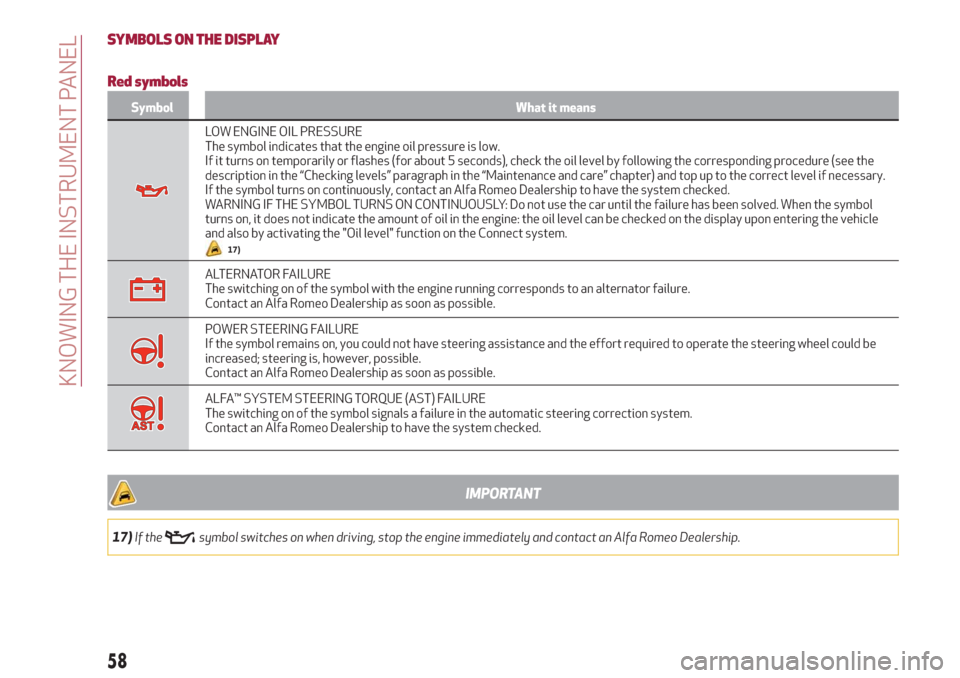
SYMBOLS ON THE DISPLAY
Red symbols
Symbol What it means
LOW ENGINE OIL PRESSURE
The symbol indicates that the engine oil pressure is low.
If it turns on temporarily or flashes (for about 5 seconds), check the oil level by following the corresponding procedure (see the
description in the “Checking levels” paragraph in the “Maintenance and care” chapter) and top up to the correct level if necessary.
If the symbol turns on continuously, contact an Alfa Romeo Dealership to have the system checked.
WARNING IF THE SYMBOL TURNS ON CONTINUOUSLY: Do not use the car until the failure has been solved. When the symbol
turns on, it does not indicate the amount of oil in the engine: the oil level can be checked on the display upon entering the vehicle
and also by activating the "Oil level" function on the Connect system.
17)
ALTERNATOR FAILURE
The switching on of the symbol with the engine running corresponds to an alternator failure.
Contact an Alfa Romeo Dealership as soon as possible.
POWER STEERING FAILURE
If the symbol remains on, you could not have steering assistance and the effort required to operate the steering wheel could be
increased; steering is, however, possible.
Contact an Alfa Romeo Dealership as soon as possible.
ALFA™ SYSTEM STEERING TORQUE (AST) FAILURE
The switching on of the symbol signals a failure in the automatic steering correction system.
Contact an Alfa Romeo Dealership to have the system checked.
IMPORTANT
17)If thesymbol switches on when driving, stop the engine immediately and contact an Alfa Romeo Dealership.
58
KNOWING THE INSTRUMENT PANEL
Page 74 of 232
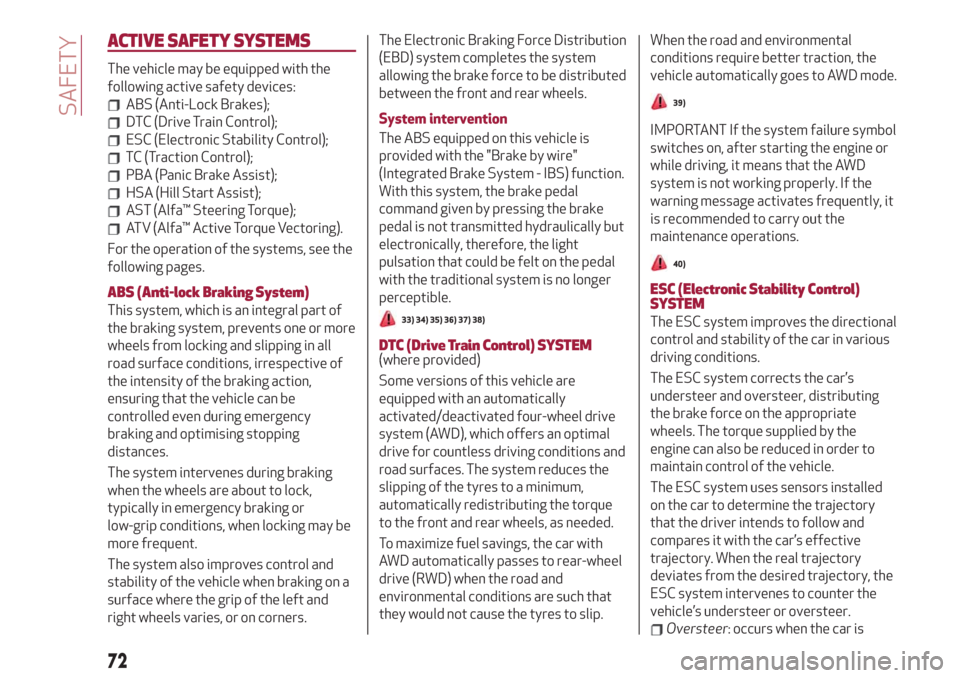
ACTIVE SAFETYSYSTEMS
The vehicle may be equipped with the
following active safety devices:
ABS (Anti-Lock Brakes);
DTC (Drive Train Control);
ESC (Electronic Stability Control);
TC (Traction Control);
PBA (Panic Brake Assist);
HSA (Hill Start Assist);
AST (Alfa™ Steering Torque);
ATV (Alfa™ Active Torque Vectoring).
For the operation of the systems, see the
following pages.
ABS (Anti-lock Braking System)
This system, which is an integral part of
the braking system, prevents one or more
wheels from locking and slipping in all
road surface conditions, irrespective of
the intensity of the braking action,
ensuring that the vehicle can be
controlled even during emergency
braking and optimising stopping
distances.
The system intervenes during braking
when the wheels are about to lock,
typically in emergency braking or
low-grip conditions, when locking may be
more frequent.
The system also improves control and
stability of the vehicle when braking on a
surface where the grip of the left and
right wheels varies, or on corners.The Electronic Braking Force Distribution
(EBD) system completes the system
allowing the brake force to be distributed
between the front and rear wheels.
System intervention
The ABS equipped on this vehicle is
provided with the "Brake by wire"
(Integrated Brake System - IBS) function.
With this system, the brake pedal
command given by pressing the brake
pedal is not transmitted hydraulically but
electronically, therefore, the light
pulsation that could be felt on the pedal
with the traditional system is no longer
perceptible.33) 34) 35) 36) 37) 38)
DTC (Drive Train Control)SYSTEM(where provided)
Some versions of this vehicle are
equipped with an automatically
activated/deactivated four-wheel drive
system (AWD), which offers an optimal
drive for countless driving conditions and
road surfaces. The system reduces the
slipping of the tyres to a minimum,
automatically redistributing the torque
to the front and rear wheels, as needed.
To maximize fuel savings, the car with
AWD automatically passes to rear-wheel
drive (RWD) when the road and
environmental conditions are such that
they would not cause the tyres to slip.When the road and environmental
conditions require better traction, the
vehicle automatically goes to AWD mode.
39)
IMPORTANT If the system failure symbol
switches on, after starting the engine or
while driving, it means that the AWD
system is not working properly. If the
warning message activates frequently, it
is recommended to carry out the
maintenance operations.
40)
ESC (Electronic Stability Control)
SYSTEM
The ESC system improves the directional
control and stability of the car in various
driving conditions.
The ESC system corrects the car’s
understeer and oversteer, distributing
the brake force on the appropriate
wheels. The torque supplied by the
engine can also be reduced in order to
maintain control of the vehicle.
The ESC system uses sensors installed
on the car to determine the trajectory
that the driver intends to follow and
compares it with the car’s effective
trajectory. When the real trajectory
deviates from the desired trajectory, the
ESC system intervenes to counter the
vehicle’s understeer or oversteer.
Oversteer: occurs when the car is
72
SAFETY
Page 75 of 232
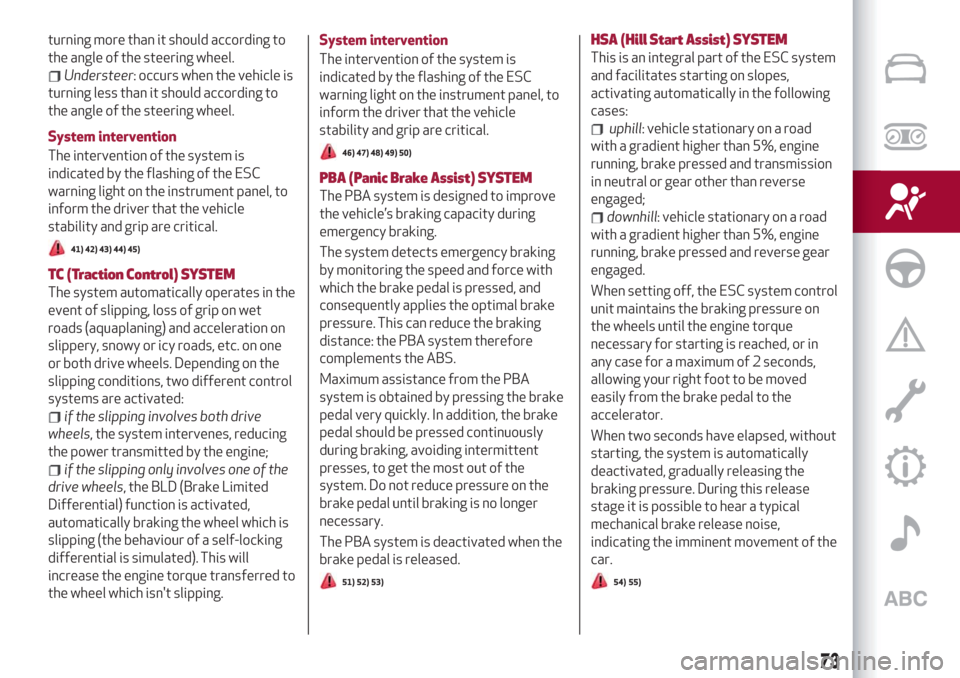
turning more than it should according to
the angle of the steering wheel.
Understeer: occurs when the vehicle is
turning less than it should according to
the angle of the steering wheel.
System intervention
The intervention of the system is
indicated by the flashing of the ESC
warning light on the instrument panel, to
inform the driver that the vehicle
stability and grip are critical.
41) 42) 43) 44) 45)
TC (Traction Control)SYSTEM
The system automatically operates in the
event of slipping, loss of grip on wet
roads (aquaplaning) and acceleration on
slippery, snowy or icy roads, etc. on one
or both drive wheels. Depending on the
slipping conditions, two different control
systems are activated:
if the slipping involves both drive
wheels, the system intervenes, reducing
the power transmitted by the engine;
if the slipping only involves one of the
drive wheels, the BLD (Brake Limited
Differential) function is activated,
automatically braking the wheel which is
slipping (the behaviour of a self-locking
differential is simulated). This will
increase the engine torque transferred to
the wheel which isn't slipping.System intervention
The intervention of the system is
indicated by the flashing of the ESC
warning light on the instrument panel, to
inform the driver that the vehicle
stability and grip are critical.
46) 47) 48) 49) 50)
PBA (Panic Brake Assist)SYSTEM
The PBA system is designed to improve
the vehicle’s braking capacity during
emergency braking.
The system detects emergency braking
by monitoring the speed and force with
which the brake pedal is pressed, and
consequently applies the optimal brake
pressure. This can reduce the braking
distance: the PBA system therefore
complements the ABS.
Maximum assistance from the PBA
system is obtained by pressing the brake
pedal very quickly. In addition, the brake
pedal should be pressed continuously
during braking, avoiding intermittent
presses, to get the most out of the
system. Do not reduce pressure on the
brake pedal until braking is no longer
necessary.
The PBA system is deactivated when the
brake pedal is released.
51) 52) 53)
HSA (Hill Start Assist)SYSTEM
This is an integral part of the ESC system
and facilitates starting on slopes,
activating automatically in the following
cases:
uphill: vehicle stationary on a road
with a gradient higher than 5%, engine
running, brake pressed and transmission
in neutral or gear other than reverse
engaged;
downhill: vehicle stationary on a road
with a gradient higher than 5%, engine
running, brake pressed and reverse gear
engaged.
When setting off, the ESC system control
unit maintains the braking pressure on
the wheels until the engine torque
necessary for starting is reached, or in
any case for a maximum of 2 seconds,
allowing your right foot to be moved
easily from the brake pedal to the
accelerator.
When two seconds have elapsed, without
starting, the system is automatically
deactivated, gradually releasing the
braking pressure. During this release
stage it is possible to hear a typical
mechanical brake release noise,
indicating the imminent movement of the
car.
54) 55)
73
Page 76 of 232
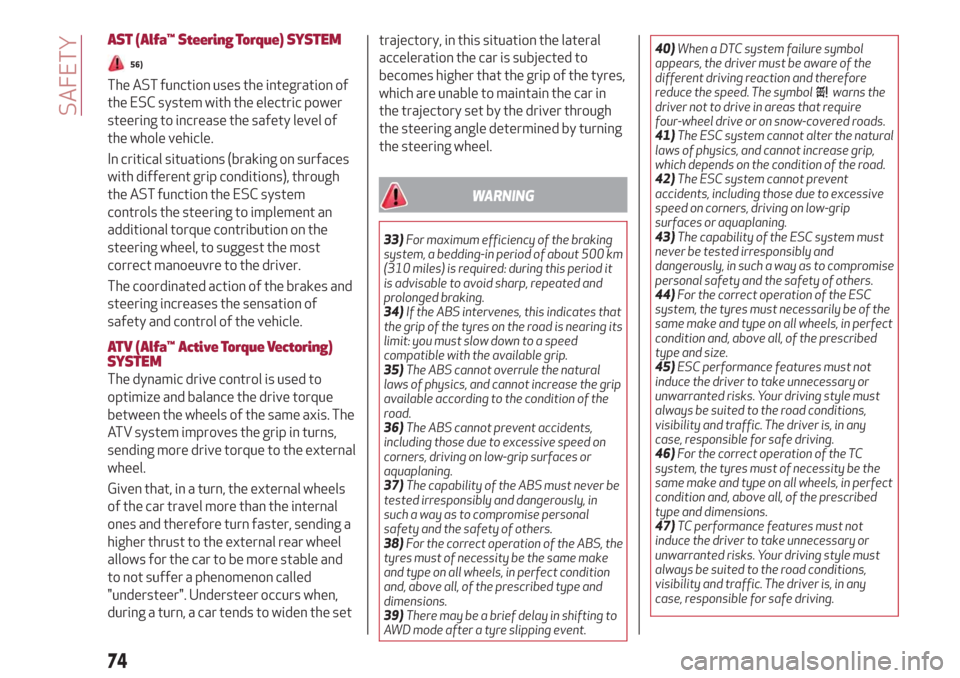
AST (Alfa™ Steering Torque)SYSTEM
56)
The AST function uses the integration of
the ESC system with the electric power
steering to increase the safety level of
the whole vehicle.
In critical situations (braking on surfaces
with different grip conditions), through
the AST function the ESC system
controls the steering to implement an
additional torque contribution on the
steering wheel, to suggest the most
correct manoeuvre to the driver.
The coordinated action of the brakes and
steering increases the sensation of
safety and control of the vehicle.
ATV (Alfa™ Active Torque Vectoring)
SYSTEM
The dynamic drive control is used to
optimize and balance the drive torque
between the wheels of the same axis. The
ATV system improves the grip in turns,
sending more drive torque to the external
wheel.
Given that, in a turn, the external wheels
of the car travel more than the internal
ones and therefore turn faster, sending a
higher thrust to the external rear wheel
allows for the car to be more stable and
to not suffer a phenomenon called
"understeer". Understeer occurs when,
during a turn, a car tends to widen the settrajectory, in this situation the lateral
acceleration the car is subjected to
becomes higher that the grip of the tyres,
which are unable to maintain the car in
the trajectory set by the driver through
the steering angle determined by turning
the steering wheel.
WARNING
33)For maximum efficiency of the braking
system, a bedding-in period of about 500 km
(310 miles) is required: during this period it
is advisable to avoid sharp, repeated and
prolonged braking.
34)If the ABS intervenes, this indicates that
the grip of the tyres on the road is nearing its
limit: you must slow down to a speed
compatible with the available grip.
35)The ABS cannot overrule the natural
laws of physics, and cannot increase the grip
available according to the condition of the
road.
36)The ABS cannot prevent accidents,
including those due to excessive speed on
corners, driving on low-grip surfaces or
aquaplaning.
37)The capability of the ABS must never be
tested irresponsibly and dangerously, in
such a way as to compromise personal
safety and the safety of others.
38)For the correct operation of the ABS, the
tyres must of necessity be the same make
and type on all wheels, in perfect condition
and, above all, of the prescribed type and
dimensions.
39)There may be a brief delay in shifting to
AWD mode after a tyre slipping event.40)When a DTC system failure symbol
appears, the driver must be aware of the
different driving reaction and therefore
reduce the speed. The symbol
warns the
driver not to drive in areas that require
four-wheel drive or on snow-covered roads.
41)The ESC system cannot alter the natural
laws of physics, and cannot increase grip,
which depends on the condition of the road.
42)The ESC system cannot prevent
accidents, including those due to excessive
speed on corners, driving on low-grip
surfaces or aquaplaning.
43)The capability of the ESC system must
never be tested irresponsibly and
dangerously, in such a way as to compromise
personal safety and the safety of others.
44)For the correct operation of the ESC
system, the tyres must necessarily be of the
same make and type on all wheels, in perfect
condition and, above all, of the prescribed
type and size.
45)ESC performance features must not
induce the driver to take unnecessary or
unwarranted risks. Your driving style must
always be suited to the road conditions,
visibility and traffic. The driver is, in any
case, responsible for safe driving.
46)For the correct operation of the TC
system, the tyres must of necessity be the
same make and type on all wheels, in perfect
condition and, above all, of the prescribed
type and dimensions.
47)TC performance features must not
induce the driver to take unnecessary or
unwarranted risks. Your driving style must
always be suited to the road conditions,
visibility and traffic. The driver is, in any
case, responsible for safe driving.
74
SAFETY
Page 227 of 232
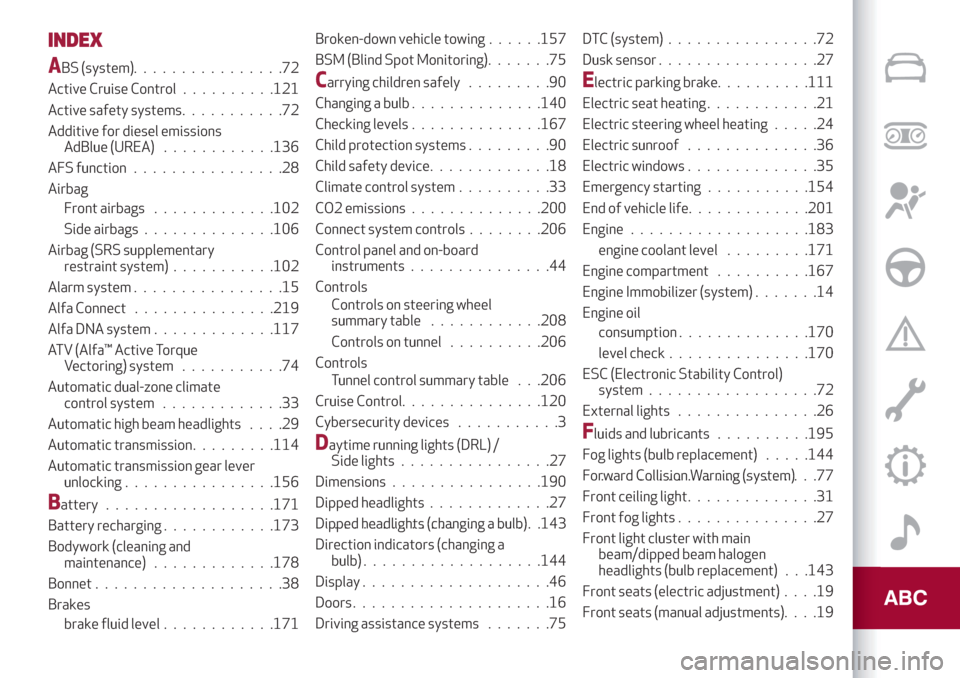
INDEX
ABS (system)................72
Active Cruise Control..........121
Active safety systems...........72
Additive for diesel emissions
AdBlue (UREA)............136
AFS function................28
Airbag
Front airbags.............102
Side airbags..............106
Airbag (SRS supplementary
restraint system)...........102
Alarm system................15
Alfa Connect...............219
Alfa DNA system.............117
ATV (Alfa™ Active Torque
Vectoring) system...........74
Automatic dual-zone climate
control system.............33
Automatic high beam headlights....29
Automatic transmission.........114
Automatic transmission gear lever
unlocking................156
Battery..................171
Battery recharging............173
Bodywork (cleaning and
maintenance).............178
Bonnet....................38
Brakes
brake fluid level............171Broken-down vehicle towing......157
BSM (Blind Spot Monitoring).......75
Carrying children safely.........90
Changing a bulb..............140
Checking levels..............167
Child protection systems.........90
Child safety device.............18
Climate control system..........33
CO2 emissions..............200
Connect system controls........206
Control panel and on-board
instruments...............44
Controls
Controls on steering wheel
summary table............208
Controls on tunnel..........206
Controls
Tunnel control summary table . . .206
Cruise Control...............120
Cybersecurity devices...........3
Daytime running lights (DRL) /
Side lights................27
Dimensions................190
Dipped headlights.............27
Dipped headlights (changing a bulb)......................143
Direction indicators (changing a
bulb)...................144
Display....................46
Doors.....................16
Driving assistance systems.......75DTC (system)................72
Dusk sensor . . ...............27
Electric parking brake..........111
Electric seat heating . . ..........21
Electric steering wheel heating.....24
Electric sunroof..............36
Electric windows..............35
Emergency starting...........154
End of vehicle life.............201
Engine...................183
engine coolant level.........171
Engine compartment..........167
Engine Immobilizer (system).......14
Engine oil
consumption . .............170
level check...............170
ESC (Electronic Stability Control)
system..................72
External lights . . .............26
Fluids and lubricants..........195
Fog lights (bulb replacement).....144
Forward Collision Warning (system).......................77
Front ceiling light..............31
Front fog lights . . .............27
Front light cluster with main
beam/dipped beam halogen
headlights (bulb replacement) . . .143
Front seats (electric adjustment)....19
Front seats (manual adjustments)....19